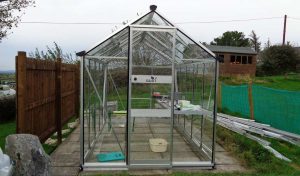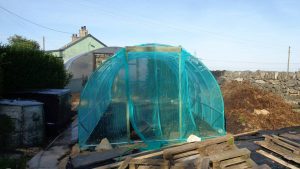Wind can be very destructive as we know but even low levels of wind can reduce crop yields and slow plant growth. Happily, there are a number of ways to protect a vegetable garden from the wind.
How wind damages the vegetable garden.
Strong winds, storms, can cause physical damage to plants. Most home growers will have had the experience of runner bean supports being blown over. We’ve even had sweetcorn plants being ripped from the ground in a summer storm.
Crop protecting cloches and even greenhouses can be destroyed by strong winds, not just plant damaging but expensive too. Protecting from the wind requires some thought and although you may need to purchase some products like these gazebo anchors, generally is not prohibitively expensive.
Lower wind speeds can have a greater effect than you realise, damaging your plants. The reason for this is the wind chill factor. As the wind blows across the plants it removes heat faster than still air. When the plants are wet, it also increases the evaporative cooling – a double hit.
These effects can reduce the effective temperature by around 25%. This can turn spring back into winter as far as the plants are concerned. Reducing 10ºC to 7ºC or lower.
Leafy plants like Brussels sprouts are particularly subject to wind damage. The winds rock the plants back and forth causing damage to their feeding roots and stunting growth at best.
Physical features can make wind damage worse.
Have you ever walked past a tall building on a windy day? The wind seems to pick up out of nowhere. What’s happening is that the tall buildings create what are essentially wind tunnels, channelling the wind and concentrating it. This can increase the wind speed in the same way that throttling a hose pipe will cause a more powerful stream from the same volume of water.
The same thing happens when you have high walls or fences. If you already have these features around your garden, pay attention to where the wind likes to flow through. Solid fences and walls can also create powerful eddies on the sheltered side that could potentially destroy your plants.
Wind Protection with Net Cloches & Tunnels
For plants that really don’t like strong winds, it’s worth looking at net cloches and tunnels. A thick wire or water pipe frame with debris netting stretched over it will reduce wind speed, force and effects greatly.
I purchased a cheap polytunnel frame and used debris netting instead of the supplied polythene skin to construct a sheltered environment for my brassicas. Another option is to use scrap wood to construct a frame for the netting.
Wind Break Fencing

Greenhouse protected from the wind by palisade fencing on one side and debris net windbreak fencing on the other
Since even hardy plants can be affected by the wind, surrounding the vegetable plot with a fence, usually a metre high but sometimes two metres, using debris netting will have a beneficial effect.
Unlike a solid fence, debris netting does not stop the wind and cause eddies on the lee side. It slows the wind speed and reduces the force so creating a sheltered micro-climate without damaging eddies and vortices.
Strong winds can cause damage to wind protection fencing and tunnels so extra bracing may be required. One easy method is to use guy ropes in the same way as they are used for a tent. These can be connected to stakes but if they’re only needed occasionally they can connected to weights like these gazebo leg weights.
Natural Wind Breaks
For large areas, field size and greater, proper shelter belts are the best solution. They consist of a band of trees and bushes to slow and deflect the wind. The shelter extends to between 15 and 20 times the distance of the height of the trees. So a tree height of 20 metres will provide good shelter for up to 400 metres from the treeline.
With a home vegetable plot, hedges or bushes in a decorative border will give a similar level of protection. Another and more productive option would be to build a strung wire fence and train blackberries, raspberries etc. along it. Vigorous blackcurrant bushes and jostaberry bushes make a useful wind break. These can even be combined with fruit trees or espalier apples.
A border of Jerusalem artichokes has traditionally been used on allotments as a shelter belt. Some sites don’t allow permanent plantings of bushes and trees but artichokes are technically an annual cropper so not a problem.
Obviously natural wind breaks take time to grow so temporary fencing may be needed in any case. Don’t forget that they also create a rain shadow and extract nutrients from the ground. You need to take this into account and that they will require annual maintenance.
Positioning Wind Protection
The main wind breaks and barriers should be placed across the prevailing wind. In much of the country the prevailing wind comes from the south west. Unfortunately this means a windbreak may be shading the vegetable garden. In this case, rather than a hedge it may be better to use a debris netting fence, somewhat lower than ideal.





